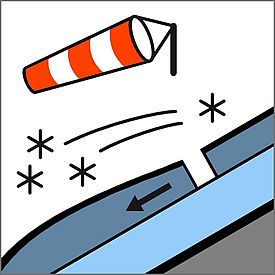
What?
Characteristics
Wind slabs are formed when loose snow in near-surface layers (new snow or old snow) is transported and deposited by wind.
Avalanche type and trigger
- Dry‐snow slab avalanches
- Natural and human triggered avalanches possible
Where?
Spatial distribution
Highly variable but typically on leeward slopes, gullies and bowls, near distinct changes in slope angle, behind ridgelines or other wind-sheltered locations. More common above treeline.
Position of the weak layer in the snowpack
Typically between wind slab and old snow or within the wind slab layers due to variations in wind speed. Occasionally slightly lower in the old snowpack. In that case, the problem “persistent weak layers” additionally prevails.
Why?
Release characteristics
The wind slab is an additional load on a weak layer and builds a slab structure that is particularly prone to being triggered.
When?
Duration
The wind slab problem can evolve very quickly. The problem lasts typically during the snowdrift event and tends to stabilize within a few days following the storm cycle.
How to manage?
Identification of the problem in the field
If not buried by new snow, the wind slab problem can be recognized with training and good visibility. Consider wind signs and locate snow drifted deposits. Typical clues: snow drifted deposits, recent avalanche activity and sometimes shooting cracks or whumpfs. However, it is often hard to determine the age of snow drifted deposits and wind signs do not necessarily imply an avalanche problem (e.g. in absence of a weak layer).
Travel advice
Avoid snow drifted deposits in steep terrain.